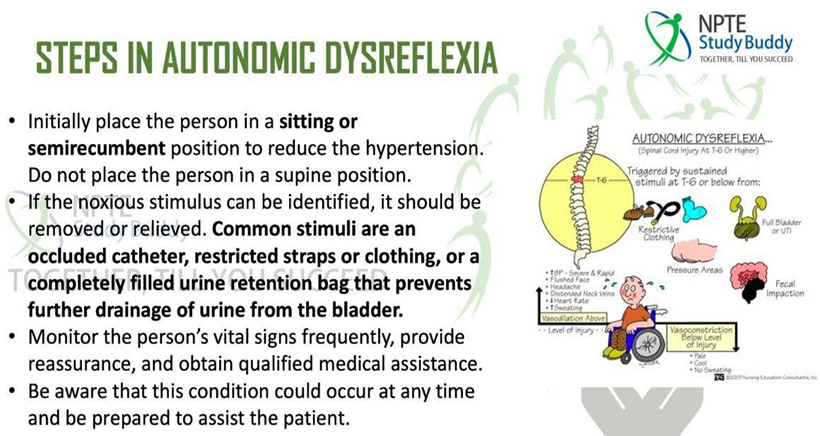A nurse is caring for a client who has a spinal cord injury and has developed autonomic dysreflexia. Identify the sequence of steps the nurse should take.
(Move the steps into the box on the right, placing them in the order of performance. Use all the steps.)
Administer an antihypertensive medication intravenously.
Confirm that the client's bladder is empty.
Indicate the risk for autonomic dysreflexia in the client's medical record.
Place the client in an upright sitting position.
The Correct Answer is D,B,A,C
Step D (Place the client in an upright sitting position): Elevating the client's head and upper body to an upright position helps to reduce blood pressure by promoting venous pooling in the lower extremities.
Step B (Confirm that the client's bladder is empty): Autonomic dysreflexia is often triggered by bladder distention or urinary retention. By confirming and addressing urinary issues promptly, the nurse can remove the triggering stimulus.
Step A (Administer an antihypertensive medication intravenously): In severe cases where blood pressure remains dangerously high despite other interventions, such as positioning and addressing bladder issues, antihypertensive medications may be necessary to lower blood pressure quickly and prevent complications.
Step C (Indicate the risk for autonomic dysreflexia in the client's medical record): Documentation of the occurrence of autonomic dysreflexia, its triggers, and interventions used is essential for continuity of care. It informs other healthcare providers about the client's condition and helps in implementing preventive strategies.

Nursing Test Bank
Naxlex Comprehensive Predictor Exams
Related Questions
Correct Answer is C
Explanation
C. Muscle twitching post-thyroidectomy can indicate hypocalcemia, a common complication due to inadvertent damage or removal of the parathyroid glands during surgery. Hypocalcemia can lead to neuromuscular irritability, including muscle twitching, tingling, or tetany.
A Nausea is a common postoperative symptom and can be caused by anesthesia, pain medications, or changes in gastrointestinal function. While uncomfortable, nausea alone is typically not an urgent concern
B Serosanguineous drainage (thin, pink-tinged fluid) from the surgical incision is expected in the early postoperative period. It indicates normal wound healing and does not usually require urgent attention
D. Routine incisional pain does not typically require urgent reporting unless accompanied by other concerning symptoms.
Correct Answer is B
Explanation
B. Changes in the fluid level of the water-seal chamber correspond to the client's breathing pattern. During inhalation, the negative pressure in the chest cavity may cause the fluid level to rise slightly as air is drawn into the tube, and during exhalation, the fluid level may fall as air exits through the chest tube.
A Fluctuations in the fluid level can occur due to changes in suction pressure settings, but this is more relevant to the suction control chamber rather than the water-seal chamber.
C. If there is continuous bubbling in the water-seal chamber, it indicates an air leak, which disrupts the normal function of the water-seal mechanism.
D. The water-seal chamber's fluctuation does not directly indicate lung re-expansion. Lung re-expansion is assessed through clinical examination, chest X-ray, or other diagnostic tests rather than the water-seal chamber.
Whether you are a student looking to ace your exams or a practicing nurse seeking to enhance your expertise , our nursing education contents will empower you with the confidence and competence to make a difference in the lives of patients and become a respected leader in the healthcare field.
Visit Naxlex, invest in your future and unlock endless possibilities with our unparalleled nursing education contents today
Report Wrong Answer on the Current Question
Do you disagree with the answer? If yes, what is your expected answer? Explain.
Kindly be descriptive with the issue you are facing.
